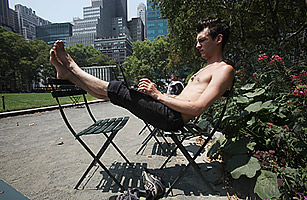
Bryant Park, New York, 2010
(2 of 2)
Anyone who has visited a park or plaza recently sees text-walkers, phone talkers, e-book readers, and laptop or tablet users. Following in the Whyte's footsteps, Keith Hampton, an assistant professor at the University of Pennsylvania's Annenberg School for Communication wondered how people with mobile devices were using urban open space now. In 2007 he embarked on a research project in cities across North America to investigate community and social interaction in the wireless city. Are we too wrapped in our own cocoons to enjoy those chance conversations with fellow bench sitters? Or, does the material on screen give us something new to talk about? Would we even be in the park if we had to communicate only with the people sitting near us?
Hampton's research showed that Internet users tended to get out more and that active users like bloggers tended to be active in "real" life as well. Some 25% of people interviewed admitted that they had not visited the public space before wifi became available and most of those said they came more often because of wifi. The average lap-top user made two hour-long visits per week. From its birth in the 19th century, the idea behind the urban park was to provide an escape from the machines and technology that dominate the cityscape outside the ornamental fence. The park is for leisure, not work. But Hampton found that over half the ICT users in Bryant Park were working.
What's different today is nature of community and communication in the park. The conversations park users are having are as likely to be with someone on the other end of the country as on the other end of the bench. And the conversation is as likely to be work-related as idle chat. When a leisure space also becomes a work place, technology is nudging conventional categories of urban space toward something new.
To famed urbanist and activist Jane Jacobs, New York was a better place for the "eyes on the street," her oft-quoted phrase that crowded sidewalks with abundant doors and windows make the city safer. What if the eyes are on the iPad? Or the ears in headphones? While 51% of Bryant Park habitués claim they are mostly working there, Hampton's research indicates that they're still paying attention to their surroundings. And, perhaps most important, these visitors chose to be there, in public, and not at their own desk or at home. Apparently, there is a there there.
This invisible technology is arguably the single biggest influence on how our cities will look, feel and function in the future. The mid-century technologies — air conditioning, the private automobile, television — all conspired to drive us out of the city, out of public space, and into our own private worlds. Now we're bringing our worlds back out into the city with us — our friends, families, photo albums, favorite music, to do lists, work projects, books, gossip and gripes.
We've had big ideas in the past about cities that turned out not as wonderful as we had hoped. Freeways and isolated residential towers seemed to make sense once, as did horizontally separating work from home and recreation. We know what a high performance building should do: sensors, GPS, and real-time communication yields data on energy and water use, air quality, and safety. But what is a high-performance urban place? The same tiny technologies that make buildings smarter can contribute to making cities better. ICT give us new ways to narrow the gap between how we hope people will use a space and how they actually might. In this case, the smartest technology is us.
For more information on the National Building Museum's Intelligent Cities Initiative that explores how data and information technology impact the way our cities look, feel and function visit: https://www.nbm.org/intelligentcities